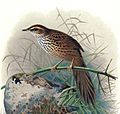Old World warbler facts for kids
The "Old World Warblers" are a large group of small birds. They used to be part of one big bird family called Sylviidae. This family had over 400 different kinds of birds. It was very confusing for scientists to sort them all out! Over time, scientists did more research. They realized many of these birds actually belonged in other families. Some of these new families include the Acrocephalidae, Cettiidae, Phylloscopidae, and Megaluridae.
What Are Old World Warblers Like?
Most Old World Warblers look quite similar. It can be hard to tell them apart! Male and female birds often look exactly the same. However, some, especially in the Sylvia group, can look different.
These birds are small to medium-sized. They are usually about 9 to 16 centimeters long. That's about the length of a pen! They have small, pointy beaks. Almost all species mostly eat insects. But some will also enjoy fruit, nectar, or tiny seeds.
Reproduction and Life Cycle
Most Old World Warblers are monogamous. This means they have one partner at a time. They build simple, cup-shaped nests in plants. Female birds lay between two and six eggs. The number of eggs depends on the specific bird species. Both parents help to raise their young. The baby birds are usually ready to fly when they are about two weeks old.
Images for kids
-
Chrysomma sinense, the yellow-eyed babbler, is a sylviid closely related to parrotbills.
-
Icterine warbler, Hippolais icterina
-
New Zealand's fernbird – probably belongs to the Locustellidae
-
Uguisu (鶯), the Japanese bush warbler (Horornis diphone). See also uguisubari.






